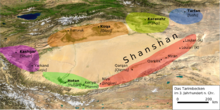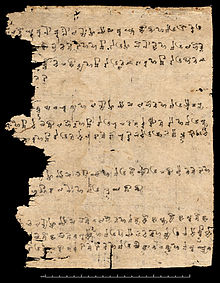Sakian language
Sakian was a central Iranian language and thus belongs to the subfamily of the Indo-Iranian branch of the Indo-European language family .
Distribution area
Sakic was a south-east Iranian language of the Central Iranian language level and was spoken by the ancient Saks ( Alt Pers. Saka- , Greek Σάκαι ) who, according to Chinese, Ancient Persian and Greek sources, had been spoken since at least 200 BC. Lived as nomads in eastern Central Asia . It was only torn from oblivion around 1900. From the early nomadic period of the Saks, only one script found in the burial mound of Issyk (4th / 3rd century BC), which was not convincingly deciphered despite several attempts at deciphering, is known, the great similarity to later, likewise not deciphered inscriptions in the historical region Bactria has, also its designation as "Sakische script" is controversial, its language and reading is so far unknown (see article Issyk-Baktrien-Schrift ).
Words, forms, names and writing habits that are typical of the Sakian language can be found in texts of the Indian Sakas or Indo-Scythians , mostly written in Sanskrit , as well as in the inscriptions and coin legends from northwest India of the Saka period (around 1st century BC). to 3rd century AD) again. According to historical and archaeological findings, Saks from Central Asia immigrated to northwest India in the 1st century BC and founded their own empires there.

In addition, Saken migrated from the 6th century BC at the latest BC also into the western Tarim Basin , where numerous complete texts of Sakian have survived as the only region. Sakisch has become known here in two dialects , which are called " Hotan- Sakisch" and " Tumxuk- Sakisch" after the main sources .
Dialects
Hotansak
material
The Hotansak language is very richly attested due to extensive text finds from Buddhist monasteries and shrines in the old kingdom of Hotan , in the wider area around today's city of Hotan (Hetian) southeast of Kashgar , as well as in the cave of the thousand Buddhas of Dunhuang . The Empire of Hotan was an important center of Buddhism in the second half of the 1st millennium AD.
The name of this language, which apparently disappeared soon after the Turkish conquest at the beginning of the 11th century, as Khotan can be based on the fact that it is mentioned in the documents themselves.

The texts, which date from the 7th to 10th centuries AD, are partly in so-called Pothi manuscripts made of elongated leaves written on both sides, which are held together by means of a string passed through holes, partly on Chinese scrolls where the backs of Chinese texts were (re) used to write down the Hotansak text. Almost all of the surviving texts are of Buddhist content, usually translations from Sanskrit ; and the fact that there are numerous, sometimes very extensive bilinguals with Chinese, Tibetan or Sanskrit parallel texts at hand, often makes their linguistic interpretation much easier.
The most important text of this group is a didactic poem belonging to the oldest attested language level , which deals with various aspects of Buddhism and tells Buddhist legends , the book of Zambasta named after its client . There are also a number of documents and other profane texts such as letters, poems and medical treatises , even a travel diary about a trip from Hotan to Srinagar . There are only a few wooden and wall inscriptions.
font

These Hotansak texts are written in different variants of the Indian Brahmi script used in Central Asia , the older literary texts in a clear book script , the later documents in a very italic style . The script had to be adapted to the phonetic characteristics of Hotansak.
Tumxuksakish
The evidence of Tumxuksak is far worse than Hotansak and is only known from a Buddhist manuscript from Tumxuk (northeast of Kashgar) and from some documents found nearby .
That it is closely related to the Hotan language and that both are just different dialects of one and the same language shows a number of morphological and lexical similarities. Tumxuksak represents a more ancient stage of development than Hotansak because it lacks certain more recent appearances.
literature
- RE Emmerick (Ed.): The Book of Zambasta. A Khotanese poem on Buddhism , ed. And translated. London 1968.
- Ronald E. Emmerick: Khotanese and Tumsuqese . In: Rüdiger Schmitt (Ed.): Compendium Linguarum Iranicarum . Wiesbaden 1989, pp. 204-229.
- Ronald E. Emmerick: A Guide to the Literature of Khotan . 2nd Edition. Tokyo 1992.
- Heinrich Lüders: The Sakas and the "Northern Aryan" language . In: Meeting reports of the Prussian Academy of Sciences , Berlin 1913, pp. 406–427.
Footnotes
- ↑ For the content of this Buddhist poem, which has only survived in Hotansak, see Encyclopædia Iranica , Ronald E. Emmerick: Book of Zambasta .